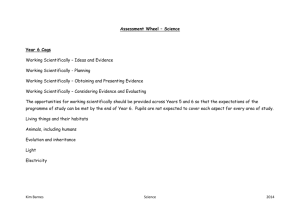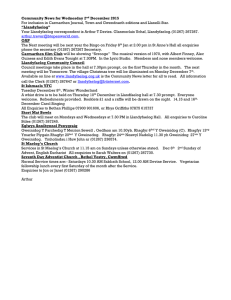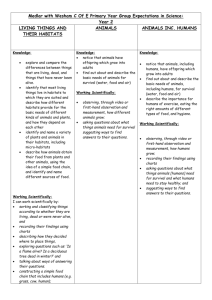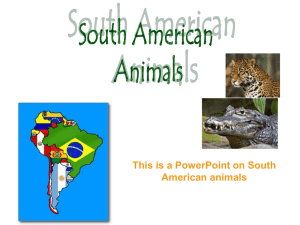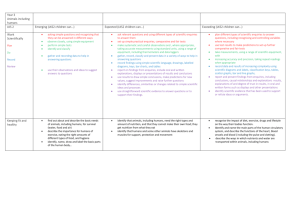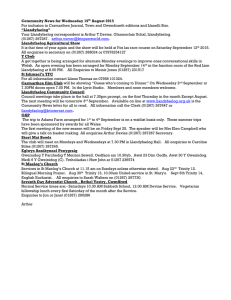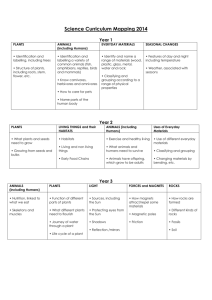Redbridge Lakes National Curriculum
advertisement
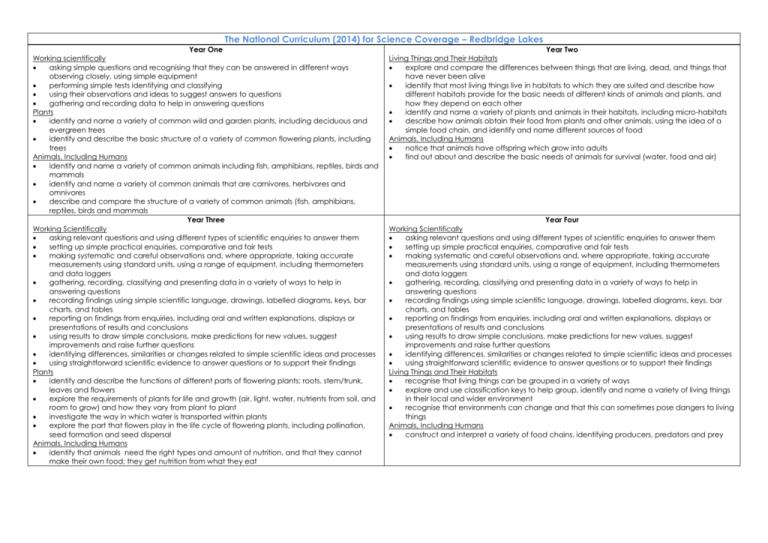
The National Curriculum (2014) for Science Coverage – Redbridge Lakes Year One Working scientifically asking simple questions and recognising that they can be answered in different ways observing closely, using simple equipment performing simple tests identifying and classifying using their observations and ideas to suggest answers to questions gathering and recording data to help in answering questions Plants identify and name a variety of common wild and garden plants, including deciduous and evergreen trees identify and describe the basic structure of a variety of common flowering plants, including trees Animals, Including Humans identify and name a variety of common animals including fish, amphibians, reptiles, birds and mammals identify and name a variety of common animals that are carnivores, herbivores and omnivores describe and compare the structure of a variety of common animals (fish, amphibians, reptiles, birds and mammals Year Three Working Scientifically asking relevant questions and using different types of scientific enquiries to answer them setting up simple practical enquiries, comparative and fair tests making systematic and careful observations and, where appropriate, taking accurate measurements using standard units, using a range of equipment, including thermometers and data loggers gathering, recording, classifying and presenting data in a variety of ways to help in answering questions recording findings using simple scientific language, drawings, labelled diagrams, keys, bar charts, and tables reporting on findings from enquiries, including oral and written explanations, displays or presentations of results and conclusions using results to draw simple conclusions, make predictions for new values, suggest improvements and raise further questions identifying differences, similarities or changes related to simple scientific ideas and processes using straightforward scientific evidence to answer questions or to support their findings Plants identify and describe the functions of different parts of flowering plants: roots, stem/trunk, leaves and flowers explore the requirements of plants for life and growth (air, light, water, nutrients from soil, and room to grow) and how they vary from plant to plant investigate the way in which water is transported within plants explore the part that flowers play in the life cycle of flowering plants, including pollination, seed formation and seed dispersal Animals, Including Humans identify that animals need the right types and amount of nutrition, and that they cannot make their own food; they get nutrition from what they eat Year Two Living Things and Their Habitats explore and compare the differences between things that are living, dead, and things that have never been alive identify that most living things live in habitats to which they are suited and describe how different habitats provide for the basic needs of different kinds of animals and plants, and how they depend on each other identify and name a variety of plants and animals in their habitats, including micro-habitats describe how animals obtain their food from plants and other animals, using the idea of a simple food chain, and identify and name different sources of food Animals, Including Humans notice that animals have offspring which grow into adults find out about and describe the basic needs of animals for survival (water, food and air) Year Four Working Scientifically asking relevant questions and using different types of scientific enquiries to answer them setting up simple practical enquiries, comparative and fair tests making systematic and careful observations and, where appropriate, taking accurate measurements using standard units, using a range of equipment, including thermometers and data loggers gathering, recording, classifying and presenting data in a variety of ways to help in answering questions recording findings using simple scientific language, drawings, labelled diagrams, keys, bar charts, and tables reporting on findings from enquiries, including oral and written explanations, displays or presentations of results and conclusions using results to draw simple conclusions, make predictions for new values, suggest improvements and raise further questions identifying differences, similarities or changes related to simple scientific ideas and processes using straightforward scientific evidence to answer questions or to support their findings Living Things and Their Habitats recognise that living things can be grouped in a variety of ways explore and use classification keys to help group, identify and name a variety of living things in their local and wider environment recognise that environments can change and that this can sometimes pose dangers to living things Animals, Including Humans construct and interpret a variety of food chains, identifying producers, predators and prey Year Five Working Scientifically planning different types of scientific enquiries to answer questions, including recognising and controlling variables where necessary taking measurements, using a range of scientific equipment, with increasing accuracy and precision, taking repeat readings when appropriate recording data and results of increasing complexity using scientific diagrams and labels, classification keys, tables, scatter graphs, bar and line graphs using test results to make predictions to set up further comparative and fair tests reporting and presenting findings from enquiries, including conclusions, causal relationships and explanations of and degree of trust in results, in oral and written forms such as displays and other presentations identifying scientific evidence that has been used to support or refute ideas or arguments Living Things and Their Habitats describe the differences in the life cycles of a mammal, an amphibian, an insect and a bird describe the life process of reproduction in some plants and animals Year Six Working Scientifically planning different types of scientific enquiries to answer questions, including recognising and controlling variables where necessary taking measurements, using a range of scientific equipment, with increasing accuracy and precision, taking repeat readings when appropriate recording data and results of increasing complexity using scientific diagrams and labels, classification keys, tables, scatter graphs, bar and line graphs using test results to make predictions to set up further comparative and fair tests reporting and presenting findings from enquiries, including conclusions, causal relationships and explanations of and degree of trust in results, in oral and written forms such as displays and other presentations identifying scientific evidence that has been used to support or refute ideas or arguments Living thing and their habitats describe how living things are classified into broad groups according to common observable characteristics and based on similarities and differences, including micro-organisms, plants and animals give reasons for classifying plants and animals based on specific characteristics Animals, including humans describe the ways in which nutrients and water are transported within animals Evolution and inheritance recognise that living things produce offspring of the same kind, but normally offspring vary and are not identical to their parents identify how animals and plants are adapted to suit their environment in different ways and that adaptation may lead to evolution Redbridge Lakes Activities Kingfisher Pool and Fishing (Redbridge Lakes staff must accompany this activity) We can show how water can be filtered naturally. We teach kids to fish. Everyone can access and thoroughly enjoy fishing as this is an activity that anyone is able to do regardless of disability. Wild Flower Meadow and Blackberry Way We can be show bees actively collecting honey and taking it back to the bee hives. We can provide opportunities to catch a variety of insects in nets including butterflies. We can help children to identify plants and to see the blackberries and elderberries that birds eat and how the seeds are distributed. Tadpole Bridge We can provide opportunities for pond dipping, particularly for frog spawn, tadpoles and frogs. Bug Hotel and Gotham Tower We can teach the importance of diversity showing that all creatures and plants depend upon each other. We can show how beetles bore into dead trees helping the breakdown of decaying wood, insects pollinate plants and birds and mammals feed off insects. We can show the habitats of different insects, birds and mammals throughout the site. Water Mill, Pond and Reeds Here we can demonstrate how a water wheel works and how it has been used to generate energy. Children can experience pumping water from the old hand pump. We can offer the opportunity to make out things out of the old reeds and willow that grows around the lakes. Chickens/Bird Watching We can give children the chance to see the life cycle of chickens. Renewable Energy, Recycling and Weather Station We can show by example how objects can be recycled and the importance of thinking sustainability. We can show how re-newable energy is generated by solar PV, solar tubes and ground source energy are used in our Eco-House. The Café We can provide space to eat packed lunches both in the cafe and the covered picnic area outside the cafe. We can section off part of the café to use as a class room and provide access to ICT and Microscopes.
